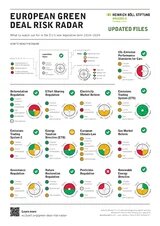There is a real risk that the European Green Deal will be weakened this new European policy cycle. What exact changes will be made to it? And will or won’t these changes ensure that we stay “the course on all of our goals”, as promised by re-elected European Commission President Ursula von der Leyen? Our new European Green Deal Risk Radar looks into that.

Check out our new European Green Deal Risk Radar!
In her Political Guidelines for 2024-2029, President Ursula von der Leyen frequently underlines that the European Commission “will stay the course on all of our goals, including those set out in the European Green Deal”. Her repeated emphasis exposes two truths.
First, it acknowledges that there are forces who indeed wish to chart a different course and limit the goals of the Green Deal. Besides populist politicians from the far-right and far-left who have called on the European Commission to “forget about the Green Deal” altogether, there are an increasing number of stakeholders who wish to see the ambitions of the Green Deal diminished.
Second, it signals that while von der Leyen is not willing to compromise on the goals of the Green Deal, she is willing to change, postpone and withdraw some of its policies. As she did, when she scrapped the EU’s pesticide reduction plan in early 2024, on the back of the farmers’ protests. The vision – achieving climate neutrality by 2050 – remains. But reality – the state of things as they currently exist – can change.
So as we enter this new EU policy cycle, the question to ask is: What exact changes will be made to the European Green Deal? And will or won’t these changes ensure that we stay “the course on all of our goals”?
Politics isn’t static. And changes to the European Green Deal can and should be made to make it more efficient, effective and expedient. But the problem with changing policies midway, is simple: It can backfire. It can diminish regulatory stability and investment security for industry, weaken confidence of the electorate in their politicians, and have unintended negative consequences. When you keep adjusting the frame, you risk shattering the whole picture.
Finally, and this is where von der Leyen’s two truths converge, other political forces can seize the agenda, forcing changes unaligned with the original goals. This is a particular concern, given the increasing anti-Green Deal sentiment in the EU – from the European Parliament, which saw a shift to the extreme right in the last election, and the EU Council, to national governments, who are dragging their feet when it comes to implementation.
There is a risk that the European Green Deal will be weakened this new European policy cycle.
It is against this very backdrop, that the Heinrich-Böll-Stiftung European Union has published the European Green Deal Risk Radar.
It analyses the state of play of the 13 most important legislative files of the European Green Deal and identifies the potential risks these laws face in view of being delayed, defunded, undermined, or even withdrawn. Valuably, it also provides a crucial timeline, highlighting when potential risks are most likely to emerge, be it because of revision clauses, delegated acts, impact assessments or a deadline for transposition into law by EU Member States.
Timely launched a few weeks ahead of EP hearings to European Commissioners-designate, our European Green Deal Risk Radar will help Green Deal champions (MEPs, civil society and stakeholders alike) to ensure that both European Commission and European Parliament live up to their energy and climate commitments during the new EU legislative cycle.


